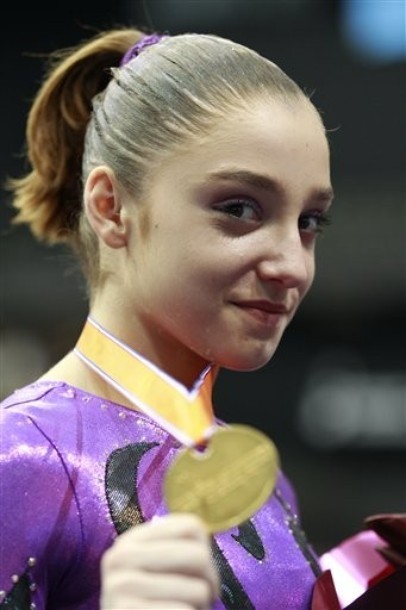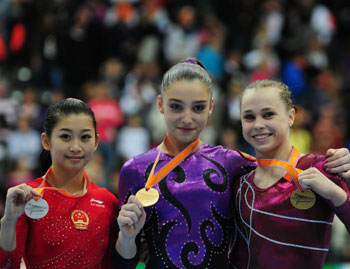Gymnasts are busy people. This year I thought I would do their NY resolutions for them.
ALEXANDRA RAISMAN
Should resolve to.....
POINT HER TOES
Aly is great and has really shown how much she is worth to the USA. She is the kind of performer you just watch: you never expect her to fall, step out or even wobble (most of the time). 2011 has been a good year for her. She has solidified her status as a reliable team performer, particularly given Alicia’s unfortunate departure from Tokyo leaving Aly as last minute team captain. Plenty of people thought the USA were toast with Alicia gone, and without Anna Li’s bars, but the whole team smashed QFs and finals and that can only look good for young captain Raisman.
However, Aly is not without her problems. Artistry and graceful expression really are her downfalls. Sadly, these problems show up the most on her best apparatus: floor and the beam. Her beam acro skills are great, but her general presentation leaves a lot to be desired. A key example of this is her paltry, perfunctory low to beam work: the most pathetic of nods to the requirement in a clunking, awkward and ugly fall to the horizontal.
So the general resolution could be a more general “pay more attention to artistry”, but that is a very broad ask. I really think that a simple, classic toe point would make all the difference. Particularly on bars, where her feet would actually look more appropriate on a cartoon duck.
GET CONSISTENT ON BARS
2 years. 2 botches.
I don’t even mean good. I just mean simply: learn to stay on there when it counts. To be honest (as I have mentioned in a previous post) I am dubious of the likelihood of Aly actually landing the second AA spot at the Olympics, with the potential of a back up to scratch Bross (amongst others). However, if she does, and misses bars, it would be the 3rd time in a row that her AA hopes were botched by a bad bars set. Even if she doesn’t have the need for a bars set beyond QFs at the Olympics, and carries on her career beyond them, she could be a real hope for an AA shot in the depleted field of the fresh quad, a la Sloan in 2009. So learn to stay on!
BETH TWEDDLE
Should resolve to.....
FOCUS ON THE BARS
In my extremely biased opinion, I think Beth’s current routine is by far the best in the world at this moment. It is clean (not on the level of Komova, admittedly) but extraordinarily difficult, with difficultly built up by not just a series of big tricks, but a series of big tricks smoothly connected. I think her performance in the team finals of this year’s worlds was the best of her career by far - something very exciting to see at this point in her career with the prospect of a home turf Olympics looming.
But this is not 2008. The new code will not let her qualify to finals with a fall, or even a mistake. Beth needs to have those connections ready to do in any circumstance.
SORT OUT THE FLOOR
Over the years, various American competitors have proven that a gymnast doesn’t have to be from a balletic background with classic long lines, or even a particularly good dancer, to put together a bloody good floor routine.
Look at Jordyn Wieber. Although her current floor routine does to some degree split opinion, I think it is one of the most expressive and original floor routines around at the moment. Wieber (like Beth) is a tumbler, not a dancer. But her current choreography shows excellent detail to the music and plays to her strengths rather than exposing her weaknesses. Similarly, the show stopper at the 2008 VISA championships was totally Chellsie Memmel’s floor routine on night two. Again, definitely a tumbler and not a dancer, but that routine was perfect for Chellsie and it brought the house down.
I have no real idea why Beth’s coaches don’t try for something similar. It would be so easy! Go for more modern music with a stronger beat, get some expressive but not balletic moves that Beth isn’t visibly cringed-out by and get confident with it! I am still (perhaps naively) hoping for her to have trained up that Arabian full out by the time of London. That, with some choreography that matches her, would be fantastic.
If she wants any chance of factoring in on the floor again, something has to change.
JORDYN WIEBER
Should resolve to......
KEEP GOING WITH THE UPGRADES
Jordyn was the star of 2011. She saw of challenged for Mustafina early on, Komova later on, and will now forever be able to say that she was the best gymnast in the world.
But it isn’t going to get any easier. She had a lot of help from Komova at this year’s worlds: no amanar, car crash beam, steps on floor. Jordyn cannot count on such luck in the coming year. She is going to need to raise her game wherever she possibly can (I am thinking at least something on everything except vault). I think some real progress could be made on bars, considering how far she came in a relatively short amount of time on this apparatus. Not long ago she was labouring through staggered toe-ons and now she has some pretty impressive combination work at the top of her routine (which she did mess up at worlds, but it is there nonetheless).
I think Jordyn is a great gymnast and deserving of this year’s accolades. But it is going to take a lot of work indeed to break the curse of the world champion going into the Olympics.
JESSICA LOPEZ
Should resolve to....
NOT LOSE FAITH
She was once quoted as saying that she would “keep going until she won a medal”, but has been showing signs of slowing down a bit recently. Not that I blame her, constant exhaustion and little reward and recognition has got to be disheartening. This is especially true when the judges slam her as much as they did at this worlds (as was brought to my attention by a recent thread on intlgymnast). The below routine was qualifications received a score lower than that of Alexandra Raisman. There are no words.
Full discussion on this insanity can be found here: http://www.american-gymnast.com/agtc/index.php/2011/12/23/and-the-award-for-the-most-outrageous-judging-moment-of-2011-goes-to/?utm_source=feedburner&utm_medium=feed&utm_campaign=Feed%3A+AmericanGymnastTrainingCenter+%28American+Gymnast+Training+Center%29&utm_content=FeedBurner
I think Jessica is a great presence and fan favourite in the sport, and it would be a shame to see her give up now.
VIKTORIA KOMOVA
Should resolve to....
WORK ON HER SPORTSMANSHIP
Not to slam her as much as many have, but by God does that girl need a “graceful loser face”. Someone should send her a copy of Miss Congeniality on DVD.
TATIANA NABIEVA
Should resolve to....
CONTINUE TO VALUE QUALITY OVER QUANTITY
The biggest chucker in chucktown watered down, polished up, and won a medal. More of this please.
THE FIG
Should resolve to....
PRODUCE A CODE THAT:
1. We all understand, from the gymnasts themselves to the seasoned fans to the people that happen to turn on a gymnastics live feed for the first time in their lives
2. Rewards in a balanced fashion the difficulty, execution, originality and artistry of the routines
3. Doesn’t create silly loopholes that come to characterise an entire apparatus (such as the rebound jumps on floor)
4. Doesn’t create an unfair scoring imbalance across apparatus (such as Lauren Mitchell).
Happy New Year everyone!
I know this is early - but I am going away tomorrow. Would love to hear any other suggestions!
I know this is early - but I am going away tomorrow. Would love to hear any other suggestions!






























